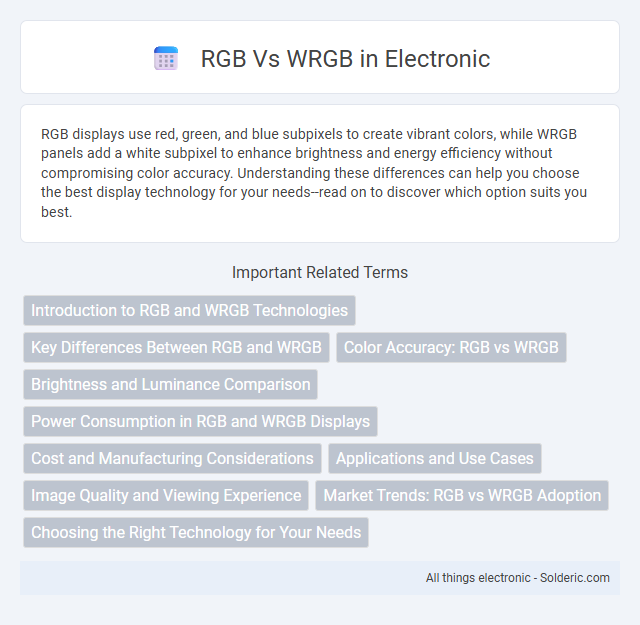RGB displays use red, green, and blue subpixels to create vibrant colors, while WRGB panels add a white subpixel to enhance brightness and energy efficiency without compromising color accuracy. Understanding these differences can help you choose the best display technology for your needs--read on to discover which option suits you best.
Comparison Table
| Feature | RGB | WRGB |
|---|---|---|
| Color Subpixels | Red, Green, Blue | Red, Green, Blue, White |
| Brightness | Standard brightness levels | Higher brightness with white subpixel |
| Color Accuracy | High color accuracy | Slightly lower color accuracy due to white subpixel |
| Power Efficiency | Lower efficiency compared to WRGB | Improved power efficiency from white subpixel |
| Usage | Common in OLED displays | Used in LG OLED TVs and displays |
| Cost | Generally lower cost | Higher manufacturing cost |
Introduction to RGB and WRGB Technologies
RGB technology uses red, green, and blue subpixels to create vivid colors on displays by mixing these primary colors. WRGB adds a white subpixel alongside the RGB trio, enhancing brightness and energy efficiency, especially in OLED screens. Your choice between RGB and WRGB affects color accuracy, brightness levels, and power consumption in modern displays.
Key Differences Between RGB and WRGB
RGB displays use three subpixels--red, green, and blue--to create colors, whereas WRGB adds a white subpixel to enhance brightness and improve energy efficiency. WRGB technology offers better luminance and more accurate color representation, especially in OLED panels. The inclusion of a white subpixel in WRGB allows for increased brightness without compromising color purity, making it ideal for HDR content.
Color Accuracy: RGB vs WRGB
RGB displays use red, green, and blue subpixels to produce color, offering high color accuracy by directly controlling each primary color. WRGB adds a white subpixel to enhance brightness and energy efficiency but can sometimes dilute color precision due to the added white channel mixing with colors. Your choice depends on whether color accuracy or brightness efficiency is more critical for your viewing needs.
Brightness and Luminance Comparison
RGB displays use three subpixels--red, green, and blue--to produce colors, while WRGB incorporates an additional white subpixel that enhances overall brightness and luminance. The inclusion of a white subpixel in WRGB panels significantly increases peak brightness levels, leading to better visibility in well-lit environments and improved HDR performance. Consequently, WRGB displays often provide higher luminance efficiency compared to traditional RGB screens, delivering more vibrant and brighter images.
Power Consumption in RGB and WRGB Displays
RGB displays consume more power as each pixel uses three subpixels (red, green, blue) that require individual illumination, whereas WRGB displays add a white subpixel that can produce brightness more efficiently, reducing overall energy use. The white subpixel in WRGB panels allows lower backlight intensity for the same brightness level, which directly decreases power consumption compared to traditional RGB displays. If you aim to optimize power efficiency in your device, choosing WRGB technology can be a smarter choice for longer battery life and lower energy costs.
Cost and Manufacturing Considerations
RGB displays typically have lower manufacturing costs due to simpler pixel structures using only red, green, and blue subpixels, reducing complexity in production. WRGB technology incorporates a white subpixel to enhance brightness and color accuracy, but this adds to manufacturing expenses through more complex layering and calibration processes. The increased material use and manufacturing precision in WRGB panels result in higher costs compared to standard RGB displays.
Applications and Use Cases
RGB displays excel in applications requiring vibrant colors and high contrast, such as OLED TVs and smartphones, providing sharp images for gaming and multimedia. WRGB technology, incorporating a white subpixel alongside red, green, and blue, enhances brightness and power efficiency, making it ideal for high-resolution displays in premium televisions and professional monitors. Your choice between RGB and WRGB should depend on whether color accuracy or brightness performance is more critical for your device's application.
Image Quality and Viewing Experience
RGB panels utilize pure Red, Green, and Blue subpixels, delivering sharper images and more accurate color reproduction, which enhances overall picture clarity and vibrancy. WRGB panels incorporate a white subpixel alongside RGB, improving brightness levels but potentially reducing color precision and image sharpness due to the added white element diluting pure colors. The viewing experience on RGB displays often features more vivid and detailed visuals, while WRGB screens offer brighter images ideal for well-lit environments but with a slight compromise in color accuracy.
Market Trends: RGB vs WRGB Adoption
Market trends reveal a growing preference for WRGB displays in premium smartphones due to their improved color accuracy and power efficiency compared to traditional RGB panels. WRGB technology incorporates a white subpixel, enhancing brightness and extending battery life, making it a favored choice for enhancing user experience. Your decision between RGB and WRGB should consider these factors, as WRGB adoption continues to rise in flagship devices.
Choosing the Right Technology for Your Needs
When deciding between RGB and WRGB technologies, consider your display's color accuracy and brightness requirements. RGB panels offer vibrant, true-to-life colors ideal for professional photo and video editing, while WRGB includes a white subpixel to enhance brightness and energy efficiency, making it suitable for bright environments and prolonged use. Your choice should align with whether color precision or overall brightness is more critical for your specific application.
RGB vs WRGB Infographic

 solderic.com
solderic.com